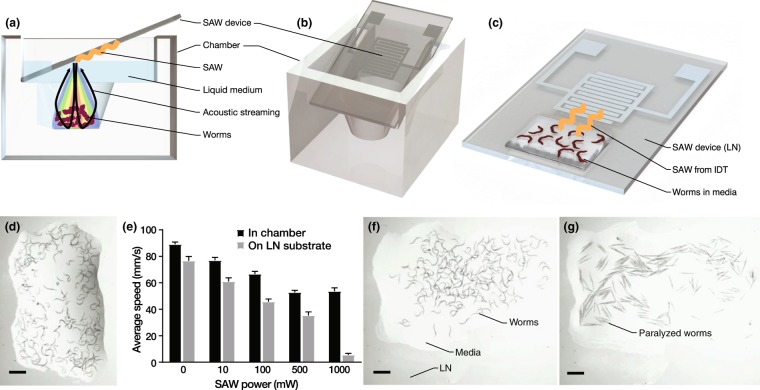Figure 1.
Two versions of the 20-MHz SAW C. elegans worm exposure concept were devised, one (a,b) introducing SAW-driven acoustic waves vertically into a chamber containing the C. elegans, and another (c) with the worms in a wetting sessile droplet of media placed directly upon the LN SAW device. The SAW device was placed at the Rayleigh angle (22°), as shown from the (a) side and (b) a perspective view, to vertically deliver the ultrasound in the well-based approach for 10 s. For scale, the (a–c) SAW device is 15 mm wide by 30 mm long. C. elegans worms are shown in a sessile droplet (d) prior to SAW exposure. The average speed of the C. elegans was then measured with them upon a solid agar plate as described in the methods. Upon increasing the SAW power in the 10-s trials to 500 mW, the worms exhibit a consistent and significant reduction in their movement speed. Here N = 3 independent trials were conducted with n = 300–500 worms per trial, and the error bars represent standard deviation. Normality of the data was assessed using the Shapiro-Wilk test with *p > α = 0.05 indicating the experimental data was normally distributed. The worms’ motility was always lower after SAW exposure in the (c) sessile droplet. As the SAW power (c) in the sessile droplet exceeds 500 mW for 10 s, the worms’ subsequent motility on an agar plate continues to decrease. Their motility remains nearly constant, however, after exposure to SAW (a,b) in the chamber. Direct (e–g) observation of the C. elegans in the (c) sessile droplet configuration showed the (e) unexposed worms to be (f) otherwise normal after experiencing 500 mW SAW for 10 s. By contrast, the worms (g) were completely paralyzed and became straight with only 5 s exposure to 1000 mW SAW. (e–g) Scale bars are 1 mm.

